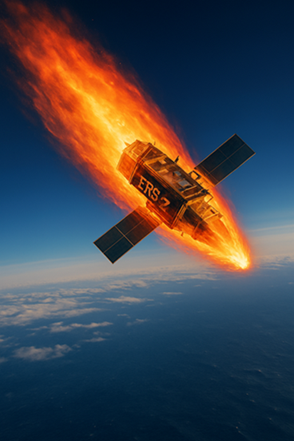(Scientists flew a plane to track a falling spacecraft and study satellite pollution, unlocking key data on reentry emissions and atmospheric impact.)

In a dramatic high-tech mission, scientists boarded a research aircraft to chase a falling European spacecraft over the Pacific Ocean in February 2024. Their goal? To investigate how satellite re-entries pollute Earth’s atmosphere—a growing concern in the era of space commercialization.
This bold operation offers a rare window into the secretive science of atmospheric pollution caused by falling satellites.
🌍 Satellite Reentry Pollution: A Rising Concern in 2025
As the number of satellites in orbit increases due to booming space industries like SpaceX’s Starlink and Amazon’s Project Kuiper, experts have sounded alarms over reentry emissions. Most satellites burn up during descent, releasing aluminum particles, soot, and vaporized metals into the atmosphere.
Recent studies suggest that these emissions may disrupt the ozone layer and affect global climate systems.
🛩️ The Chase Mission: How Scientists Tracked a Falling Spacecraft
To better understand these impacts, a team led by Aerospace Corporation flew a modified aircraft equipped with specialized sensors to follow the ESA’s ERS-2 satellite, which was reentering Earth’s atmosphere uncontrollably.
Key Details of the Operation:
- Date of Reentry: February 21, 2024
- Location Tracked: South Pacific Ocean
- Satellite: European Remote Sensing Satellite (ERS-2)
- Flight Altitude: 12,000 meters
- Data Collected: Infrared emissions, particulate matter, chemical analysis
🔬 “This was our best chance to gather real-time data on spacecraft reentry emissions,” said Dr. James Magee, an atmospheric scientist at Aerospace Corp.
📊 What the Early Data Reveals
Initial findings indicate:
- Aluminum oxide particles were detected, known to affect stratospheric chemistry.
- Emissions included carbon-based soot, which contributes to atmospheric warming.
- Reentry debris burns at over 1,500°C, producing a metallic vapor that lingers in the upper atmosphere.
A NASA 2022 study had already warned that reentry pollution might increase by 5,000% by 2030 if unchecked.
📡 Why This Matters in the Era of Satellite Mega-Constellations
The satellite industry is growing rapidly:
- Over 8,000 active satellites are currently in orbit.
- More than 50,000 new satellites are expected by 2030.
This means more frequent reentries, more pollution, and bigger atmospheric risks.
Potential Environmental Impacts:
- Depletion of the ozone layer by metallic aerosols
- Acceleration of climate change via carbon emissions
- Unknown long-term effects on human health and ecosystems
The Aerospace Corporation: Satellite Reentry Research
Use when quoting Dr. James Magee or about the aircraft mission.
❓FAQs on Satellite Pollution & Reentry Missions
1. Why do scientists study satellite reentry?
To understand how burning satellites releases chemicals and particles that may damage the atmosphere and climate (Spacecraft).
2. What kind of pollution do satellites cause?
Mainly metallic particles (like aluminum oxide) and soot, which can affect the ozone layer and global temperatures.
3. Is satellite reentry pollution harmful to humans?
While most pollutants stay high in the atmosphere, they can influence climate systems that indirectly impact human health.
4. Can satellite reentry be controlled to reduce pollution?
Yes, future spacecraft may use green reentry technologies or controlled burns to minimize emissions.
5. How many satellites fall to Earth each year?
Roughly 100–150 satellites reenter Earth’s atmosphere annually, with numbers expected to rise.
🔍 Final Thoughts: A Sky Full of Risks?
This groundbreaking chase mission marks a new chapter in space environmental science. With Earth’s orbit becoming increasingly crowded, it’s vital to monitor not just what goes up—but how it comes down.
As governments and private firms race to expand satellite coverage, they must also invest in eco-friendly reentry solutions and enforce international space pollution regulations.
💬 Your Turn: What Do You Think?
Should satellite launches be more strictly regulated to prevent air pollution?






